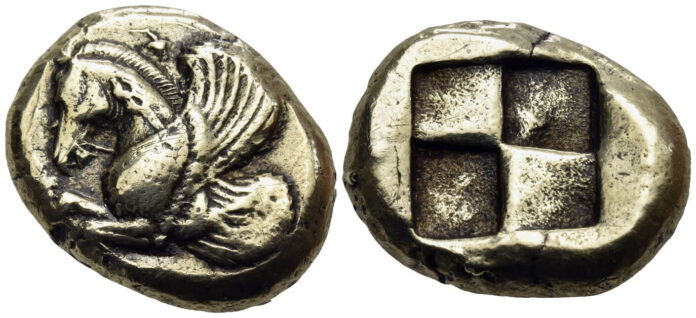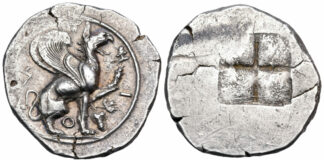Obolos 18 Results
Yes, indeed, Obolos 18 did very, very well. The total starting price for the 1,016 lots in the sale came up to 290,415 CHF, but the total selling price, with 98.62% sold, was 750,189 CHF! That certainly looks pretty good to me. There were no less than 8,077 bids placed by 694 different bidders. Let’s look at few interesting results:
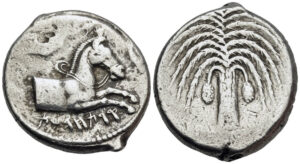
The attractive gold example of “Celtic Ring Money” appeared as lot 16 (SP 400 CHF) – 6 bidders wanted it and it finally sold for 1,300 CHF.
Remember the noble looking man-headed bull, the river-god on a coin of the Hyrianoi (“Hyria”). The starting price of 300 CHF was pushed up by 12 bidders to 1,300 CHF!
A very rare Carthaginian issue from Entella, lot 73 (SP 300 CHF) – with ten bidders it went up to 2400 CHF.
As you may remember, this was a favourite of mine, the Himera hemidrachm, lot 78, with an excellent pedigree and a painterly style: it sold for 1300 CHF (SP 450 CHF).
Rarity is important – the stater from Argos Amphilochikon, lot 196, had an SP of 125 CHF, but despite its faults it sold for 1,400 CHF! With a total of no less than 17 bids!
In the last newsletter prior to the sale I wrote about the Theban stater, lot 207, and the unusual magistrate’s name, Fαστιας (= Wastias), that appeared on it (SP 400 CHF). There were no less than 18 bids on this coin, and it finally sold for 3,000!
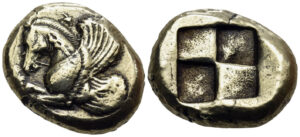
With an interesting pedigree (Vecchi 1, 1996, 289 and the von Aulock Collection – SNG 1289) the electrum stater of Lampsakos, lot 256, was quite desirable; and, so, with 14 bids it soared from an SP of 1,250 CHF to a hammer price of 5,500 CHF!
Sometimes we see a coin that has definitely suffered the ravages of time, either by wear or corrosion, but it still retains its beauty and power. Lot 310 (SP 100 CHF), is a rare drachm from the Carian city of Idyma (it was published by Ashton as Hecatomnus 4b – one of the 44 known examples of this type). Despite the corrosion on the obverse, and the fact that the photo of the reverse is presented upside-down (a common mistake but the legend cannot possibly start on the bottom right and go clockwise), the facing head of Pan is quite simply remarkable in its power – it received 10 bids and deservedly soared up to 1,000 CHF!
Remember 319, that drachm of Kos I liked so much? It went from a starting price of 150 CHF to 750 CHF; and there were 19 bids on it!
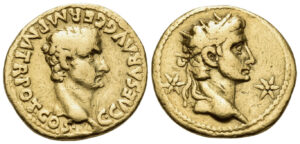
Lot 537, the aureus of Caligula with Divus Augustus (SP 1,500 CHF) had, it must be admitted, a really low starting price, but 16 bids drove it up to 22,000 – and the winning bidder’s bid was, in fact, much higher!
In fact, across the board, the Trausnitz Roman gold, which was generally of moderate quality, did very well, indeed.
And another one: The Galba, lot 538 (SP 4,000 CHF), went up to 13,000 CHF.
Other coins sold for about the same as their cost prices. This aureus of Plotina (lot 580, SP 2,000 CHF) which, in 2011, was estimated for 5,000 EUR and sold for 5,500 EUR, was one of the very last coins to enter the collection. Now it sold for 6,500 CHF, which today is about 5,900 EUR.
Lot 606 is one of the very few coins to show the portraits of Commodus and his brother Annius Verus as children. It is coin from Tarsus (SP 100 CHF). It received 19 bids and went up to 700 CHF!
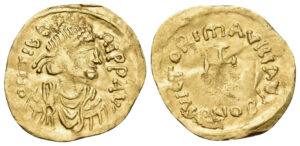
Moving on, later Roman and Byzantine gold did very well overall, especially those that were both unusual and rare. I would think that most normal people seeing lot 819, and assuming it to be just a tremissis of Maurice Tiberius, would think the best thing to do with it would be to melt it! But our erudite and learned cataloguers, realizing that the weight of this piece – 0.74 g – was impossible for any normal Byzantine tremissis, realized that it was actually an extremely rare half-tremissis. In any event, this piece (SP 500 CHF) went to a highly specialized collector for 2,400 CHF!
Byzantine coins all did well: the tremissis of Michael III, lot 884, struck in “rose gold” (= electrum) in Syracuse c. 856-866 (SP 200 CHF), soared up to 1,200 CHF! When it was acquired in October 2002 it sold for 210 EUR, up from an estimate of 150 EUR!
With 23 bids lot 930, a silver 2/3 Miliaresion of the unfortunate emperor Romanus IV, was a desirable rarity, though its condition is not particularly good (SP 100 CHF). Back in 2009 it sold for 400 EUR or 600 CHF. Now it zoomed up to 1,800 CHF!
Obolos 18 featured two silver aspers from the Empire of the Trebizond, and both did exceedingly, even fantastically, well. Lot 979 (SP 50 CHF), was struck by Manuel I Comnenus 1238-1263. Twelve bidders drove it up to 1,400 CHF!
The final lot for today is one of the few modern pieces in the Trausnitz Collection. It is a ducat of the Swedish King Gustav II Adolphus, struck in Nuremberg in 1632 (lot 993 SP 700 CHF). This is quite a good piece. I am most embarrassed to point out that I omitted to use the new standard reference on Swedish gold in cataloguing it, Roberto Delzanno, Sveriges Guldmynt/Goldmünzen aus Schweden/Gold Coins from Sweden 1512-2020. Stockholm, 2019, even though Mr Delzanno actually sent me a copy of that excellent book as a gift and it is on my desk (albeit under a copy of Coin Hoards IX)! It appears there as Delzanno (Gustav II Adolf) 85. In any case a knowledgeable bidder bought it for 2,200 CHF.
These are just a few of the many, many highlights of Obolos 18. You can scroll through all prices realized on the website of Nomos.



